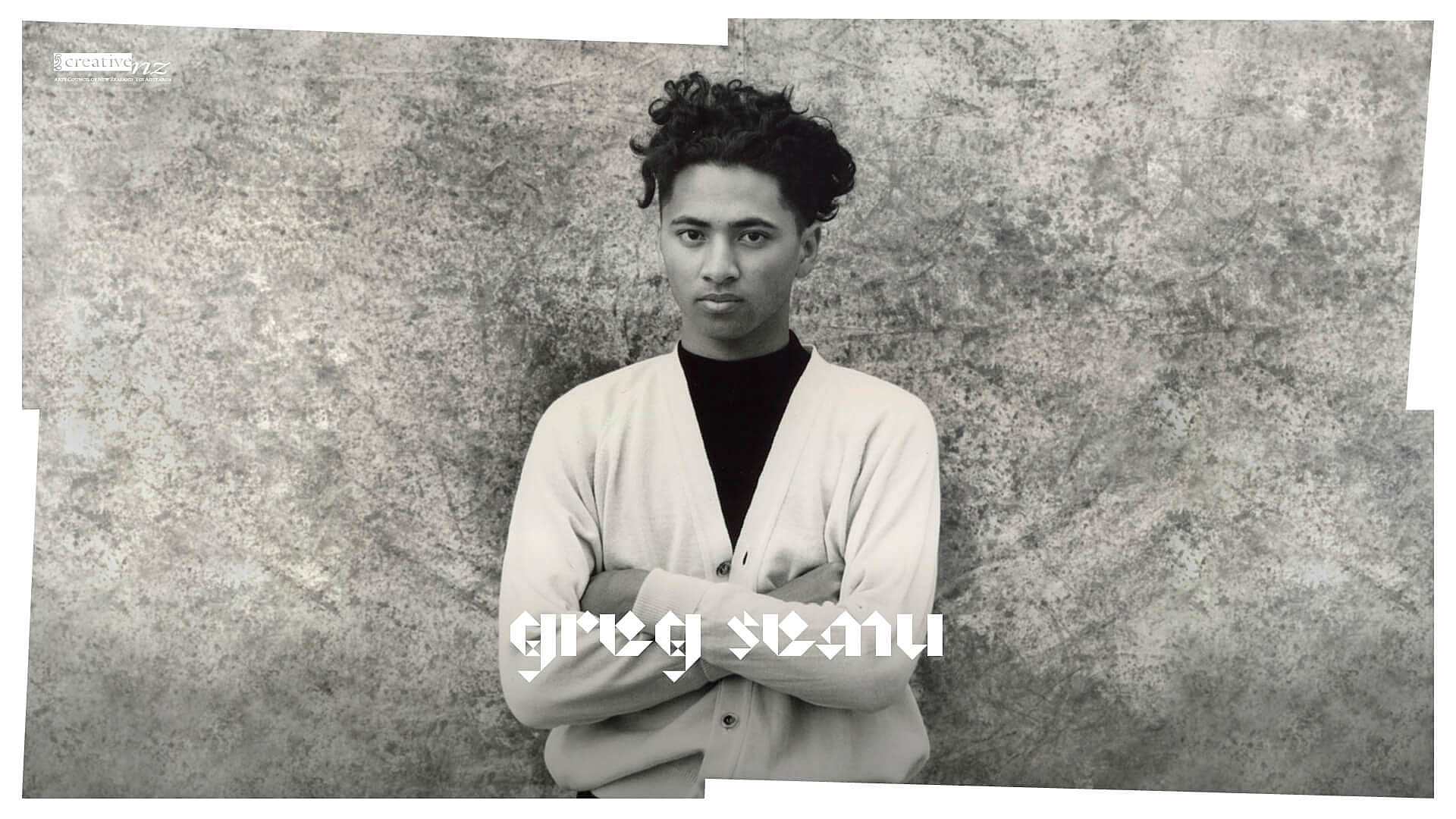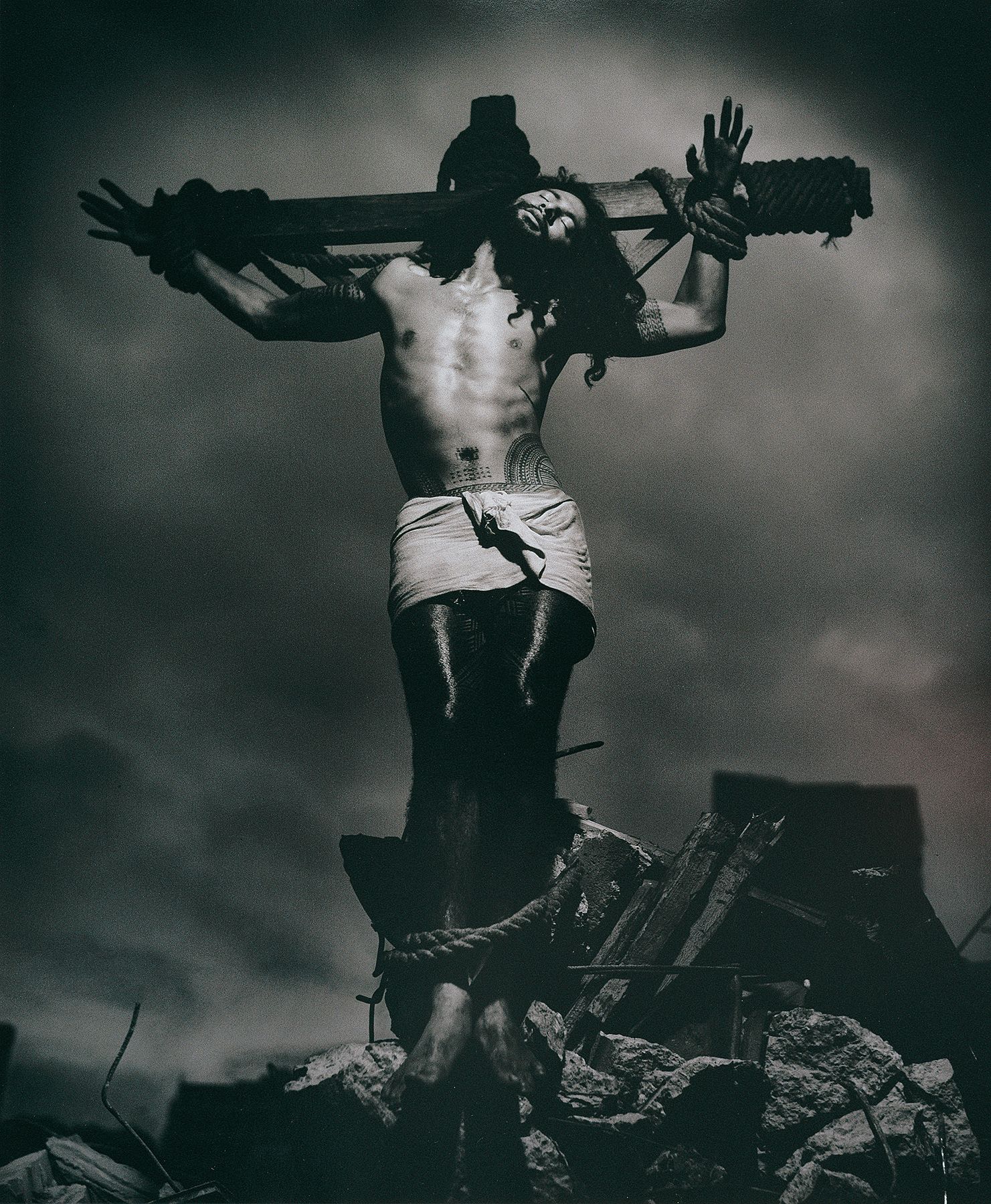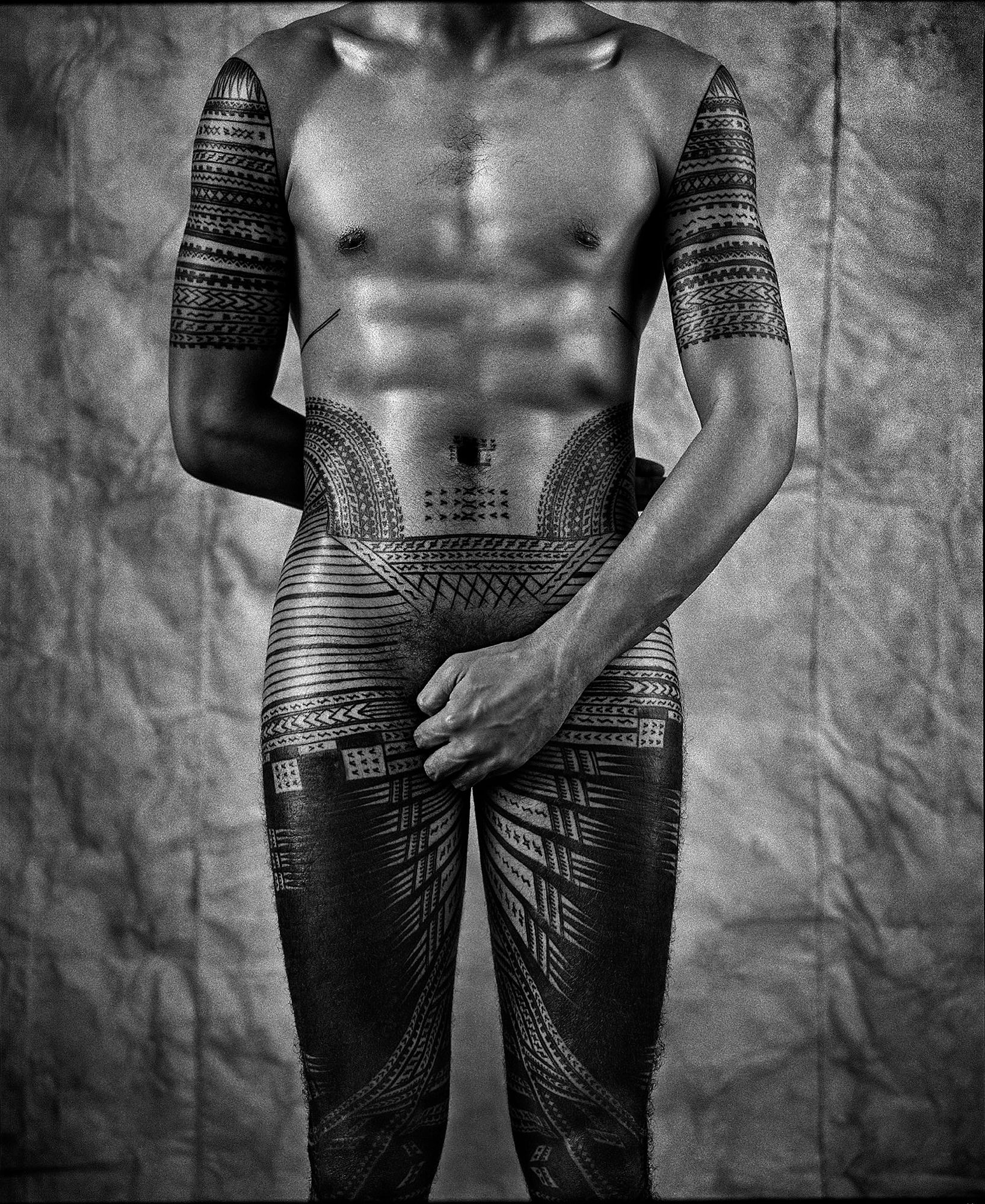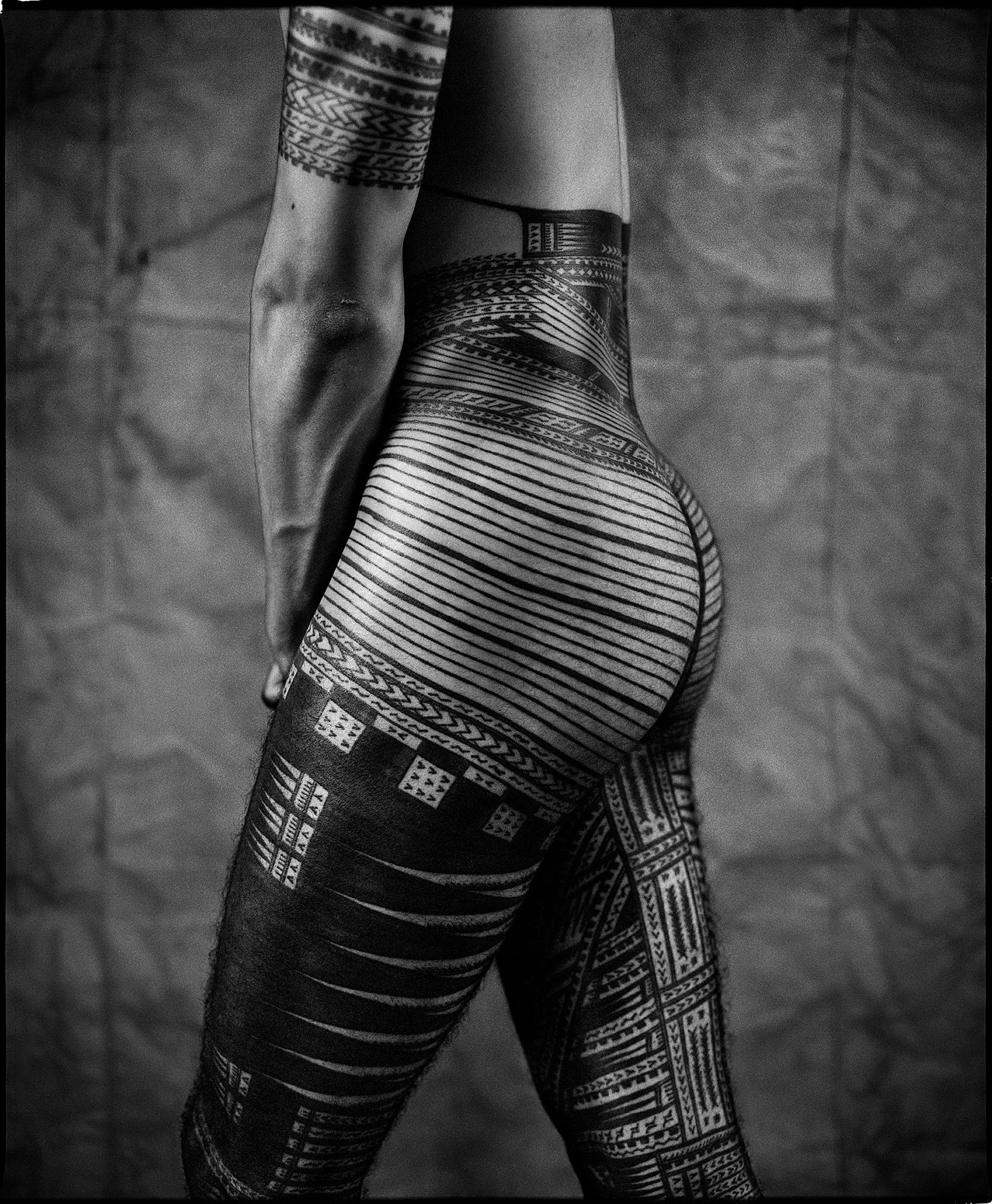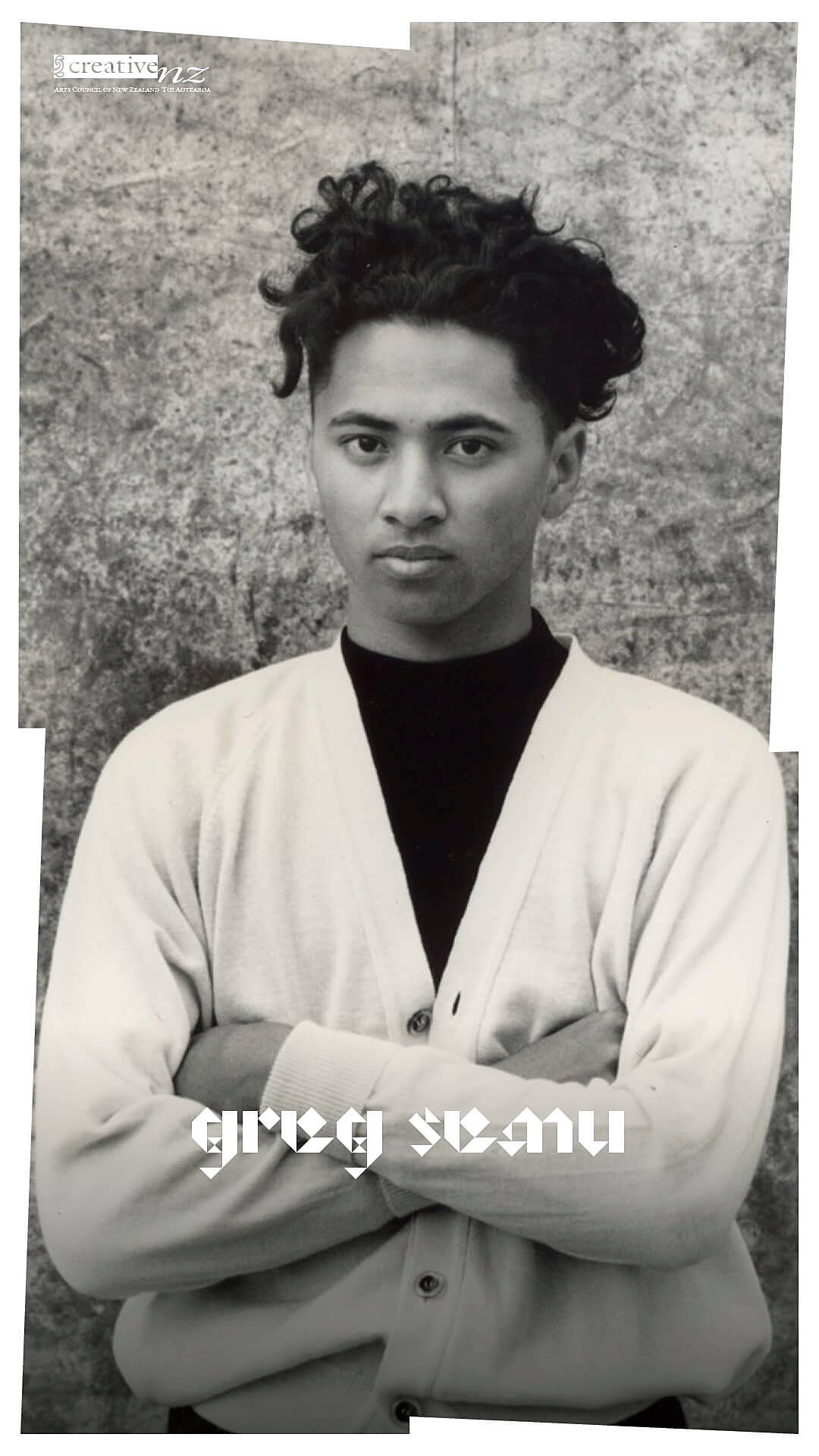Cinder-Fella’s Glass Slipper
Reach out and reach up to the stars that you fell from, is the message photographer Greg Semu has for all those born of guilt, shame, fear, rejection, denial.
We’re collaborating with Creative New Zealand to bring you the groundbreaking Pacific Arts Legacy Project. Curated by Lana Lopesi as project Editor-in-Chief, it’s a foundational history of Pacific arts in Aotearoa as told from the perspective of the artists who were there.
This is my first memory.
It is late at night and I am lying in my cot in the front-right-hand room of a lower-socioeconomic, four-bedroom house. I share this room with who I perceive as my sister, who is eight years my senior.
In my mind I can speak. I am communicating I am thirsty, and I want a drink. In reality, it is the insistent squawking and squeaking of an annoying, crying, hungry baby. I am six months old.
I remember my sister’s “Sshhhhhh”, followed by a repetitive “Be quiet! Go to sleep!” echoing through the black of night. But I was thirsty, and her whispers encouraged me to cry louder in protest.
Nek minnit, a door opens abruptly! A bright shaft of light gouges its way out, into the room of darkness, cleaving my creamed-coloured enamel-painted wooden cot in half.
The sudden interruption has snapped me into consciousness, as I feel the heat of blunt force wipe across my face, followed by a shockwave of pain. I am wide awake, fully alert. My vision is completely filled with a man’s silhouetted face, staring me down with anger, hatred and discontent.
This is my second memory.
I am less than two years old, maybe 18 months. I am standing in the hallway of the same four-bedroom house in Blockhouse Bay, Auckland, in the year 1972 possibly 73? It is daytime, but the hallway is darkened by rows of closed doors on both sides, creating what you call in architecture a ‘single-point’ perspective. There are eight doors in total and an open-faced broom cupboard midway down on my right. At the end of the hall, out of view, are the front and back doors of the house in opposition to each other and consisting of three and four panels of glass respectively, allowing light to filter in, enhancing and elongating that single-point perspective.
I am standing at the darkest, furthest, end of the hall, away from the light. I am frozen to the spot in deep thought, wearing my favourite chocolate-brown corduroy overalls. My attention is totally captured by dual sensations in opposition, taking place in and around my body. The first sensation is the frontal downward pain of churning and pushing out in my stomach, followed by the second sensation, of heat, resistance and the heaviness of expansion as ‘push-back’ triggered by the strain and stretch of containment in the rear of my favourite chocolate-brown corduroy overalls.
That was the last time I would see or wear those overalls.
Based on just these first two conscious memories, would it be difficult and unfair to make a long-term prediction? The data could suggest a life of discipline and incontinence. Either way, traumatised from birth. I did not speak until my fourth year. A polite euphemism for a ‘life’ of having the shit beaten out of you. My family thought I was mute. I was fuming!
A polite euphemism for a ‘life’ of having the shit beaten out of you.
The man with the silhouetted face I will call ‘Dad’ for the next 21 years. In return, he will never call me ‘son’, he will never speak a word of kindness or encouragement, he will never support me emotionally or lovingly. Hand to heart he was a good man, a provider and protector. He just hated me for the sin that my birth represented. I would get my drink in the end. But the price I paid would cost me dearly.
In my fifth year, I will attempt to commit suicide twice and fail. My sixth year I shit my pants at primary school, my eighth year baptised, 12th year ordained as a deacon in our family’s chosen practice of religious faith, to which we are fidel several generations and compounding. Boy scouts somewhere in between. I will not make it to the next level at sweet 16, priesthood.
At 15 years I will be told in a nonchalant way by my eldest male sibling that my brothers, sisters, mother and father are not my brothers, sisters, mother and father.
I am stunned!
The unexpected force of this blunt revelation will pulverise me to my core. Typically clichéd, I have never felt so lost, so unloved, so unwanted, so abandoned, so betrayed, so broken as at this moment.
The weight crushes me. I collapse into a crumpled heap and fall through the floor of reality as it drops, spinning away into a downward spiralling rotating vertigo that will consume three decades of my life to negotiate, and still counting.
I have never felt so lost, so unloved, so unwanted, so abandoned, so betrayed, so broken as at this moment.
Trust no one, especially not family.
If I were to sum up my life’s narrative as a children's story, then I choose the story of Cinderella. Urbanised, ghetto-fied and gender reassigned. Our protagonist ‘Cinder-Fella’, first-generation New Zealand-born of Sāmoan migrants at The Bethany Centre, a maternity hospital for unmarried women. 35 Dryden Street, Grey Lynn, in the year of our lord 1971. A bastard boy primed for adoption.
The Bethany Centre closed the hospital wing in 1976. It was the last of seven remaining Salvation Army-run maternity centres and was demolished in 2012 after 110 years of service to the community.
Unlike Cinderella, who knows she is an adoptee and accepts her cruel siblings’ and stepmother’s abuse and beatings in exchange for food, clothes, shelter, Cinder-Fella, believing he is of righteous birth, cannot understand and cannot accept ‘why’ or ‘how’ his own flesh and blood can be so vicious, violent, cruel and unjust towards one of their own.
Suffering, injustice, oppression, displacement, trauma are qualities and experiences that will formulate the foundations of my future art practice, amongst other things, with profound impact, fuelling a burning sense of duty to reach out to the millions who are secretly isolated and suffering in silence.
Silence only protects the abusers of this world and empowers them; silence only harms the victimised and alienates them from pursuing potential avenues of redemption.
And thus begins the incredible journey of our young, unloved, unwanted, traumatised, vagabond Cinder-Fella plummeting his merry way through the cracks of life and society, predestined and preordained by the environment he was born into. Indoctrinated values prioritising poverty, struggle, denial. I was instructed daily that I would never amount to anything. I would never succeed, never be anyone – or anybody of any significance, or worth.
By the time I am 12 years old my programming will be complete. I will have zero confidence, no self-esteem, be extremely racist, xenophobic, and a fully-fledged homophobe because God, Son, and Holy Ghost have no mercy, misogynistic, chronically depressed, self-righteous and ablaze with self-hatred.
A walking time-bomb guaranteed to implode.
At 13, I will learn to run, hide, steal, suffer. Steal to survive and suffer in silence. Lying is something I will try to avoid at all costs, after having been caught in an explicit web of someone else’s design. Fighting back was deprogrammed. Resistance was the next best thing, but it is nowhere near as effective or efficient.
I will run, Logan’s Run. Like Kunta Kinte I run. Through the streets I run, ‘all city’ ‘inner city’ ‘city wide’, westside, southside and central districts I run. Run away from my parents, my family, my culture, from my religion I run. I will run to New York, Paris, Berlin and finally Sydney, Australia.
I will hide. I will hide in the wardrobe of my parents, my wardrobe, the wardrobe of my first love. I will hide in the warm embrace of drug addiction. In the darkest corners I wrap myself up with it. Dedicate myself to my new religion of being high-ly dysfunctional. And I will follow my new religion around the world and visit the many temples designated to the practice and worship.
I will do everything I can to numb the pain of my past and the words of my guardians, my grandparents, my siblings – who are really my uncles and aunties. I will steal to survive. I steal my brother’s clothes cause I have none, and he has everything. I wear my school uniform 24/7 until I learn how to use a sewing machine. I will teach myself how to sew and do my own alterations to the hand-me-downs given, or the op-shop’ finds I can afford. I will become chronically truant and I will revolt against my hypocritical church upbringing. If you make me the ‘sinner’ in your narrative, then I will play the ‘sinner’ in your narrative.
Guilt, Shame, Fear will be my assigned angelic enforcers. Making sure I feel guilt, shame, fear every day. My family mantra bestowed upon me was, “Whatever you do Greg, don’t shame the family!” My very birth encapsulates the family’s shame. I will never reach for the stars carrying that crucifix.
Guilt, Shame, Fear will be my assigned angelic enforcers.
Auto Portrait with Crucifix (Auto Portrait series, 2004). Collection QAGGOMA. originally commissioned by ArtSpace Auckland. NZ 1996-7
I learn I am Sāmoan not from other Sāmoans, but from the differentiation of the Pālagi world.
At six years old I am told I am a Sāmoan, by my Pālagi primary school teacher.
One day at Chaucer Primary, the teacher – a tall, skinny, thick-glassed and balding male dressed in layers of light and dark browns. Brown pants, shoes, shirt, a cardigan-vest and tie. Awkward, shabby, wrinkly, lanky-looking man whose name I have no recollection of – is teaching geography. The Pearl of the South Seas, the Sāmoan archipelago to be precise. The schoolteacher would blah blah something about Sāmoan life, and for some reason he would stop and speak loudly across the room directly to me, “Is that right Greg?”
I was deeply confused by this. His beady laser-beam eyes, piercing through the room from behind coke-bottle bifocals, “… is that right Greg?” This was the third time he had asked me for verification of some random cultural fact. “In Samoa, the toilets are shacks, built on sticks protruding over the sea, connected to the land by a raised footbridge and you defecate straight into the ocean? An ocean long-drop?”
A long pause, as I digest the situation for what seems like an eternity, being only six years old. Conclusion?
I did not speak my grandparents’ native tongue in our suburban Lego land, nestled near the border of western and central districts.
He thinks I am a native. This is the first time I will be presented with the ‘origin’ narrative, and the first time I will truly question my own origin narrative. I did not speak my grandparents’ native tongue in our suburban Lego land, nestled near the border of western and central districts. I have not yet had the opportunity to visit the ancestral islands of my ancestral origins. I am galvanised, as I shrug my shoulders in agreement, out of the fear and shame of looking dumb. That was the moment I understood separation! A profound, crystallised sense of understanding.
A few seconds ago, we were all just children in a classroom. Like Adam, taking the first bite from Eve’s apple. Knowledge claims me an outcast. Expelled from the garden of Eden, excluded from the class of just children.
If not segregation by shared genealogy, then dictated by implemented social policies and town planers.
The Auckland that I know and experience is segregated, and it is an ‘Auki-Lagi’ phenomenon only. Birds of a feather flock together, concentrated poverty, social, cultural and economic clusters. The ‘Ōtara Chopping Mall’ incident. A violent, fatal, almost full decapitation encounter between a Sāmoan and a Tongan youth, renaming Ōtara Shopping Mall in the act. Mid 80s and early 90s will vastly change dynamics from the 70s. Mimicking pop culture cinema, Warriors and Beat Street movies spawned street gangs like the Homeboys, TCGs/Tongan Crip Gang, Suicides and KCs/King Cobras, just to name a few. Māori gangs, Black Power/Mangu Kaha and Mongrel Mob. If not segregation by shared genealogy, then dictated by implemented social policies and town planers. From the Homeboys came ‘Super Sāmoan’ Mark Hunt. The Headhunters were originally Sāmoans. Numerous untold stories of battleground ‘legends’ the word count limits me from sharing.
The Pacific communities were deeply divided and fiercely defended in Tāmaki Makaurau. An unwelcome, barely tolerated, tsunami of migratory economic necessity. This formula would not replicate anywhere else in Aotearoa New Zealand. Outside Auckland, all islanders were curated under the same umbrella as Māori. White and ‘other’.
An unwelcome, barely tolerated, tsunami of migratory economic necessity.
The first intervention will arrive in the form of a young, super-talented, gifted photographer and cinematographer whose very few words of advice will have an everlasting impact – Darryl Ward. The first of many Pālagi mentors to magically materialise.
Around 16 years, I and another colleague of Rarotongan mixed heritage whose name I forget have recently bonded in the video game arcades of Queen Street. We are mucking about till the early hours of the morning, waiting for the first bus home, killing time and being juvenile delinquents. We were hanging out at the late-night jazz club Café Le Bom. Two Polynesian street kids with nowhere to go, infiltrating the periphery when Darryl, a complete stranger, gave my friend his business card, Stratford Productions. They were looking for new faces and talent for fashion shoots. I kept the card. My friend was the taller, better-looking, more handsome one. I wonder what happened to him. I saw him once more after that, I remember him asking me if I called the number.
Fuck, two people one card?
I never saw him again. Please forgive me friend, washed in from the streets. Was that your ‘wave’ I hijacked?
I called the number.
I meet Kerry Brown, and I do my first modelling assignment with New Zealand clothing labels and future patrons Standard Issue and Workshop. My closed loop has been penetrated. Instead of a pumpkin carriage, it will be denimwear, knitwear and an opportunity.
I shared those clothes and breadcrumbs with my tribe of many orphans.
Darryl, Kerry and soon-to-arrive Rosanna Raymond will become long-time collaborators, friends and mentors. Print, film, TV, music, fashion, arts, theatre collaborations. Underground dance parties, raves, clubs, etc. A mushrooming of subcultures, platforms, collectives, magazines Planet, Stamp, Swerve, Pavement, Pulp, clubs, bars, cafes, markets.
Agencies of various kinds breastfeeding from the seedy nipple of hospitality, events management, alcohol, drugs and mass marketing. We grind tooth and nail for years, decades, lifetimes. Too often, for too long, with back-breaking next-to-nothing budgets. The old number 8 wire, ‘race you to the bottom’ kiwi mentality
At 19 to 20 years Japanese photographer Haru Sameshima's intervention at Carrington Polytechnic, (now UNITEC) was a game-changer. At 22, I will meet Pālagi photographer Mark Adams, who will personally introduce me to our master. The late, great Tufuga Ta Tatau, Su‘a Suluape Paulo II, who will fundamentally impregnate the virility of my evolving art practice.
Ten days before my 23rd birthday I will commence my initiation into receiving the Pe’a. By the skin of my teeth, I endure three months and I am reborn. The year is 1994.
Only through the passage of pain, coupled with time, will your suffering be rendered visible.
Thus, the atonement and sacred covenant of the Tatau.
Auto Portrait with Tatau, Basque Road, Newton Gully, 1995 (front), (Auto Portrait series, 2004). Collection QAGGOMA.
Auto Portrait with Tatau, Basque Road, Newton Gully, 1995 (back), (Auto Portrait series, 2004). Collection QAGGOMA.
Auto Portrait with Tatau, Basque Road, Newton Gully, 1995 (side), (Auto Portrait series, 2004). Collection QAGGOMA.
Not everyone will fit the glass slipper.
Cinder-Fella’s Glass Slipper.
To all the bastards born of guilt, shame, fear, rejection, denial. You are worthy! I salute you, honour you, and invite you to reclaim your kingdom and your voice. Give yourself permission. Put down your weapons and your burden and your shame and your fear and your guilt and reach out and reach up to the stars that you fell from.
*
This piece is published in collaboration with Creative New Zealand as part of the Pacific Arts Legacy Project, an initiative under Creative New Zealand’s Pacific Arts Strategy. Lana Lopesi is Editor-in-Chief of the project.
Series design by Shaun Naufahu, Alt group. Header photograph: 15/16-year-old Greg Semu, Standard Issue Archive 1986. Photo Kerry Brown.
